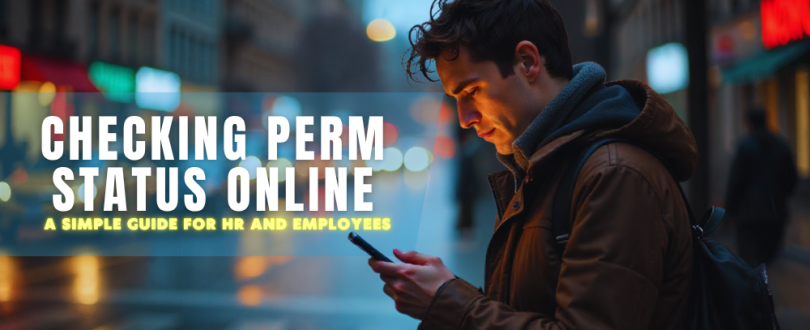
What is PERM?
PERM stands for Program Electronic Review Management, a system implemented by the U.S. Department of Labor (DOL) to streamline labor certification for employment-based green cards. Simply put, it’s the first step in getting a green card through an employer—and without it, most employment-based green card cases can’t move forward.
Why is PERM Important in Employment-Based Green Cards?
PERM ensures that hiring a foreign worker won’t negatively impact U.S. job opportunities. Before a company can sponsor a foreign worker for a green card, it must prove that no qualified U.S. workers were willing or available to take the job.
The Three Phases of the PERM Process
1. Prevailing Wage Determination – The DOL determines the minimum salary for the job.
2. Recruitment – The employer advertises the job to prove U.S. workers were considered.
3. Filing the ETA-9089 – The official PERM form submitted to the DOL for approval.
Key Stakeholders in the PERM Process
Role of the Employer
Employers initiate and control the entire process. They’re responsible for advertising the job, preparing documentation, and filing the PERM application.
Role of the Employee
While the foreign national benefits from the process, they can’t file on their own. However, they can stay in touch with HR or the immigration attorney to get updates.
Role of the Department of Labor (DOL)
The DOL oversees PERM to ensure that job opportunities are fairly offered to U.S. workers before being extended to foreign nationals.

How to File a PERM Application
Steps Employers Must Take Before Filing
Before filing, the employer must:
– Get a Prevailing Wage Determination from DOL
– Conduct proper recruitment as required by law
– Document all efforts and prepare ETA-9089
Online Filing vs. Mail Filing
Online filing through the DOL’s FLAG system is much faster and trackable, while mail submissions are rare and take longer.
What Happens After Submission?
After filing, the DOL reviews the application. It may:
– Approve (certify) the PERM
– Issue an audit (request for more info)
– Deny the application
PERM Processing Times
Factors That Affect PERM Timelines
Processing times depend on:
– Whether the case is audited
– DOL workload
– Accuracy of application
Regular vs. Audit Processing Times
– Regular Cases: Typically 6–9 months
– Audited Cases: Can take 12+ months
Current DOL Processing Time Averages
You can check updated timelines on the DOL’s official website, which is refreshed monthly.
PERM Status Check: How to Do It
How Employers Can Check PERM Status
Employers (or their attorneys) can log into the DOL FLAG portal to check the current status of the application.
How Employees Can Stay Informed
Employees can’t directly check the status but should stay in communication with:
– Their employer’s HR department
– The immigration attorney handling the case
Key Status Messages Explained
In Process – Still under review
Certified – Approved, and can proceed to I-140
Denied – Not approved, with possible options to appeal
Audit Review – Under further investigation by DOL
Common Reasons for PERM Delays
Audit Triggers
Audits can be random or due to:
– Inconsistencies in recruitment
– Suspicious job requirements
– Lack of documentation
Incomplete Documentation
Even minor errors can trigger delays or denials. Thorough prep is key.
Prevailing Wage Issues
If the employer offers below the DOL’s prevailing wage, the application can’t move forward.
What to Do if the PERM is Denied
Appealing the Decision
Employers can file a Request for Reconsideration or appeal to the Board of Alien Labor Certification Appeals (BALCA).
Refiling the PERM Application
Sometimes it’s faster to correct mistakes and refile rather than appeal.
Exploring Alternative Visa Options
In cases of repeated denials, employers may consider H-1B, O-1, or other work visa categories.

Post-PERM Steps for Green Card Sponsorship
I-140 Filing After PERM Approval
Once PERM is approved, employers file Form I-140 with USCIS to petition for the worker’s permanent residency.
Adjustment of Status or Consular Processing
After I-140 approval, employees can apply for:
– Adjustment of Status (if in the U.S.)
– Consular Processing (if outside the U.S.)
Timeline From PERM to Green Card
Depending on priority dates and country caps, it may take:
– 1–2 years for most cases
– 5–10+ years for oversubscribed countries like India or China
Tips for a Smooth PERM Process
Stay Organized and Communicate
Keep detailed records of recruitment steps and wage details. Employers and employees should stay in close contact.
Work With Experienced Immigration Attorneys
Immigration law is complex—working with professionals can save time, money, and headaches.
Keep Up With DOL Updates
Stay updated on changes in rules, processing times, or prevailing wages through the DOL website.
Conclusion
The PERM process is a vital step in the employment-based green card journey. For both employers and employees, understanding how it works—and how to track its status—can make a big difference in navigating this complex system. With proper planning, communication, and guidance, the PERM road doesn’t have to be a bumpy one.
FAQs
1. How long does a PERM application stay valid?
Once certified, the PERM is valid for 180 days. During this period, the employer must file the I-140 petition.
2. Can employees check the PERM status themselves?
Not directly. Only the employer or attorney can access the FLAG system. Employees should request updates from them.
3. What if the employer refuses to share status updates?
It’s a tricky situation. Employees may try escalating the request internally or consult with an attorney if necessary.
4. How long after PERM approval can I file I-140?
Immediately. The I-140 must be filed within 180 days of PERM approval.
5. What’s the fastest way to get a PERM approved?
Avoid errors, prepare thorough documentation, use the FLAG system for filing, and stay audit-ready.

